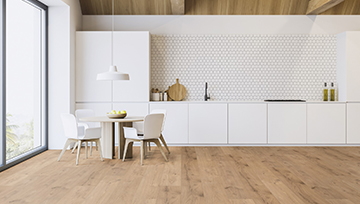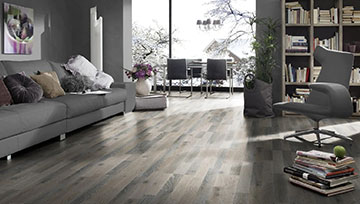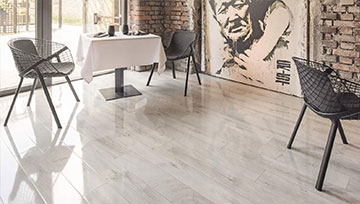Home Improvement Guide
Laminate Flooring: What You Need to Know About a Versatile All-Rounder!
Since laminate floors were invented in the 1980s in southern Sweden, a lot has changed! Attractive and durable laminate floors are now available in many appealing designs and various qualities. Laminate is a type of flooring with many strengths. In this article, you will learn everything important about the composition and the pros and cons of laminate floors. As a helpful guide, it will assist you in choosing your new flooring.
Why is Laminate So Popular?
Laminate floors are robust and easy-to-maintain all-rounders with a great price-performance ratio.
The variety of different design options, easy installation, and uncomplicated maintenance make laminate an attractive and practical flooring option for residential and commercial spaces.
Because laminate floors can be quickly and cleanly installed with a patented click mechanism, they are particularly popular among DIY enthusiasts and hobby interior designers.
Solidly crafted wood fiber panels with an authentic appearance make a strong impression and are comparatively affordable.
Since laminate floors can be installed without adhesive, they are perfect for quick and convenient renovations.
The scratch and water-resistant laminated surface ensures high durability and easy cleaning.
What is Laminate Made Of?
Those who believe that there is a lot of plastic involved in laminate flooring are mistaken! Laminate floors are made up of at least 90% real wood in the form of high-density fiberboard (HDF) or, in rare cases, less durable medium-density fiberboard (MDF) panels. Quality laminate is always manufactured from at least four carefully coordinated layers:
- Scratch-resistant and abrasion-resistant top layer made of melamine resin as a sealant
- Authentic decorative layer with photorealistic wood, stone, or fantasy design
- Wooden core material with a click mechanism (made of HDF or MDF panels of various quality grades)
- Back layer (possibly with integrated impact sound insulation) for increased dimensional stability
How Do I Recognize Quality Laminate?
The higher the quality of the individual components of laminate, the more durable and resilient your chosen flooring will be in everyday use.
You can recognize the quality of laminate mainly by its thickness and the solid craftsmanship of the materials used. The more or less functional click system is also an important quality feature for installation and dimensional stability of the floor.
Not every laminate variant is equally suitable for every type of use.
As with any flooring, a glance at the usage class of the laminate will reliably help you with your selection.
In rarely used guest rooms, you can opt for a thinner and more cost-effective floor than in high-traffic areas.
In heavily frequented entrance areas or for commercial use, you should pay attention to particularly robust quality, high abrasion resistance, and solid swelling protection.
Which Rooms are Suitable for Classic Laminate Floors?
An attractive laminate floor enhances any room in an affordable and practical way. Laminate floors with a low construction height are perfect for the individual facelift in rental apartments and for quick and cost-effective renovations in old buildings.
Do you want to quickly add more ambiance and hygienic practicality to the vacation apartment, hobby cellar, or your bedroom? An affordable laminate variant with an attractive real wood decor makes seldom-used rooms inviting and homely.
Do you like light pine with a lively ship's floor look, or do you prefer dark country house planks with subtle oak grain? With laminate floors, almost any decorative variant is possible. Let yourself be enchanted by the variety of natural and extravagant designs!
For children's rooms, living, dining, and workspaces, you should opt for the more robust laminate variant in case of doubt. In these more heavily and regularly used rooms, it is not worth saving in the wrong place. After all, your new floor should provide long-lasting enjoyment! Some laminate floors with particularly swell-protected support panels are even suitable for wet rooms to a limited extent. Not sure which laminate quality to choose for your living and working areas? Give us a call! Our expert team is happy to assist you with questions and doubts.
What do the Individual Use Classes Mean for Flooring?
A floor in the home living room is usually subjected to less stress than the floor in a large office. The classification into usage classes therefore serves as a guideline for the durability of each type of flooring. There is a distinction between commercial and private use. Floors suitable for commercial use start with the digit 3, while those for private living spaces start with the number 2. Since there are also significant differences in usage behavior within private and commercial areas, the second digit reveals more about the load-bearing capacity in the private or business environment:
Usage Class Overview
-
Private
- Usage Class 21: low use (e.g., in bedrooms or guest rooms)
- Usage Class 22: normal use (e.g., in living or dining rooms)
- Usage Class 23: heavy use (e.g., kitchens, hallways, work or children's rooms)
-
Commercial
- Usage Class 31: low use (e.g., hotel rooms)
- Usage Class 32: normal use (e.g., offices, waiting rooms, small shops)
- Usage Class 33: heavy use (e.g., department stores, large offices)
- Usage Class 34: intensive use (e.g., airports, multipurpose halls)
-
Industrial
- Usage Classes 41 - 43
Specifically for laminate, there is another parameter that plays an important role in quality. The abrasion resistance of laminate is classified using the so-called IP value. The IP value is determined through sophisticated usage tests and is an important indicator of the durability and longevity of this flooring:
Overview of the Abrasion Resistance of Laminate Floors
- AC1: IP value ≥ 900 revolutions: best used without street shoes
- AC2: IP value ≥ 1,500 revolutions: not suitable for direct entrance areas
- AC3: IP value ≥ 2,000 revolutions: normal wear and tear
- AC4: IP value ≥ 4,000 revolutions: suitable for residential spaces and light to moderate commercial use
- AC5: IP value ≥ 6,000 revolutions: exceptionally durable all-rounder for the highest level of wear and tear
The Six Key Advantages of Laminate Flooring
By now, you've probably discovered many of the advantages of this attractive classic flooring option yourself. In the following overview, we've compiled the key benefits for you:
- Outstanding Price-Performance Ratio: This is one of the biggest advantages of this flooring. For a relatively small investment, you get a well-crafted and attractive floor to suit your taste.
- For many, the extensive selection of different designs is a decisive advantage. Deceptively realistic wood or stone appearances are no problem for laminate flooring. Oak laminate in various grain patterns and textures, walnut, maple, or pine laminates are often indistinguishable from real wood at first or second glance. Even marble and stone floors can be perfectly imitated by high-quality laminates.
- Laminate floors are wonderfully easy to install. With the patented click systems of various laminate manufacturers, even beginners can handle it. Since laminate floors are usually installed as floating floors, you can even take your favorite floor with you when you move.
- Laminate floors are particularly easy to care for and resistant to dirt. This makes the anti-static flooring hygienic and also ideal for allergy sufferers. Maintenance involves regular vacuuming and damp mopping with clear water. Be cautious with oil-based cleaning agents, as they can leave an unsightly film on the laminate floor.
- Laminate floors are perfect for underfloor heating. Since this flooring hardly insulates, the heat from underfloor heating can work efficiently.
- Laminate floors are highly lightfast. Even under strong sunlight, the color of the laminate floor remains vivid and beautiful, just like on the first day.
The Three Key Disadvantages of Laminate Flooring
Although laminate floors have many advantages in various aspects, they also come with a few disadvantages that we want to mention:
- Laminate floors are never completely silent. In heavily frequented rooms, you should never skip using an underlayment for sound insulation. Otherwise, the footstep noise will eventually become quite bothersome. Whether you choose to install the floor as a floating floor on an insulation mat or opt for laminate flooring with integrated insulation is always worth considering. We are happy to advise you on the advantages and disadvantages of the available options if you're unsure!
- Unlike real wood, you cannot sand laminate floors. Once the robust and scratch-resistant protective layer has worn off, replacing the laminate planks is often the only alternative. For individual scratches, you can temporarily improve the appearance with hard wax in the laminate color. To prevent this, it's advisable to choose a slightly higher usage class or order enough laminate planks for future repairs.
- Laminate floors tend to be cold underfoot. Although the lack of insulation in combination with underfloor heating is a significant advantage, this can be uncomfortable in cold basements. Therefore, an underlayment with an integrated vapor barrier is always recommended for laminate floors. High-quality and innovative laminate solutions have already addressed this minor issue. The integrated sound insulation also provides thermal insulation.
Our Conclusion
For those looking for a durable and resilient floor with an attractive design at a budget-friendly price, the vast selection of authentic decors from various manufacturers will surely help you find your favorite quickly.
If you want to enjoy this floor for a longer time, consider choosing a higher usage class and a solid-quality product.
Laminate floors are practical for everyday use, robust, and hygienic. If you prefer a flooring option that requires minimal time and effort for maintenance, then this is the right choice for you.
Ensure good moisture insulation from below and the appropriate thermal and impact sound insulation.
For those who want to bring individual ambiance to their rental apartment quickly and affordably, laminate floors will be appreciated. However, if you are looking for a floor for life, you might find another type of flooring more suitable in the long run!














Comments